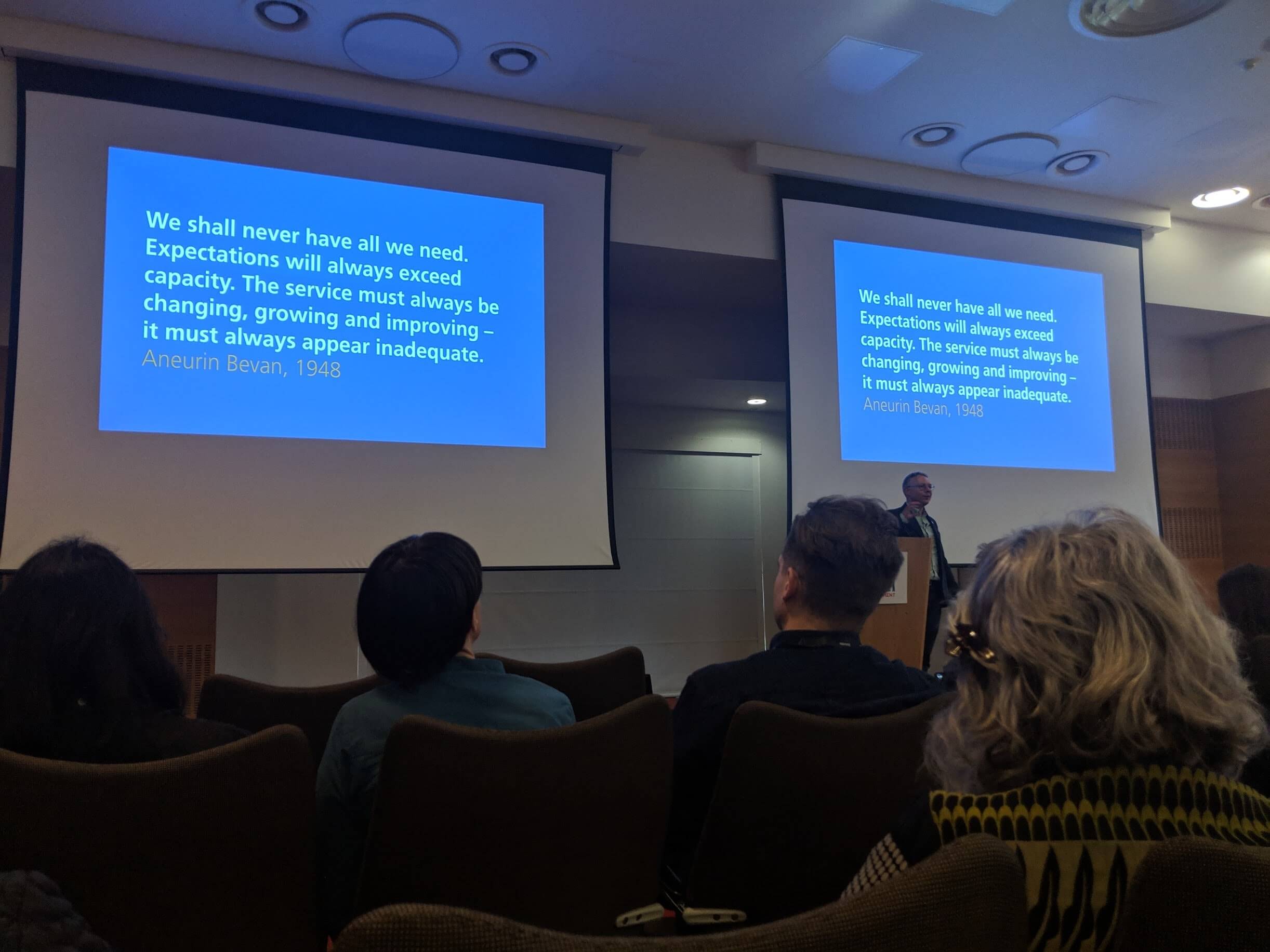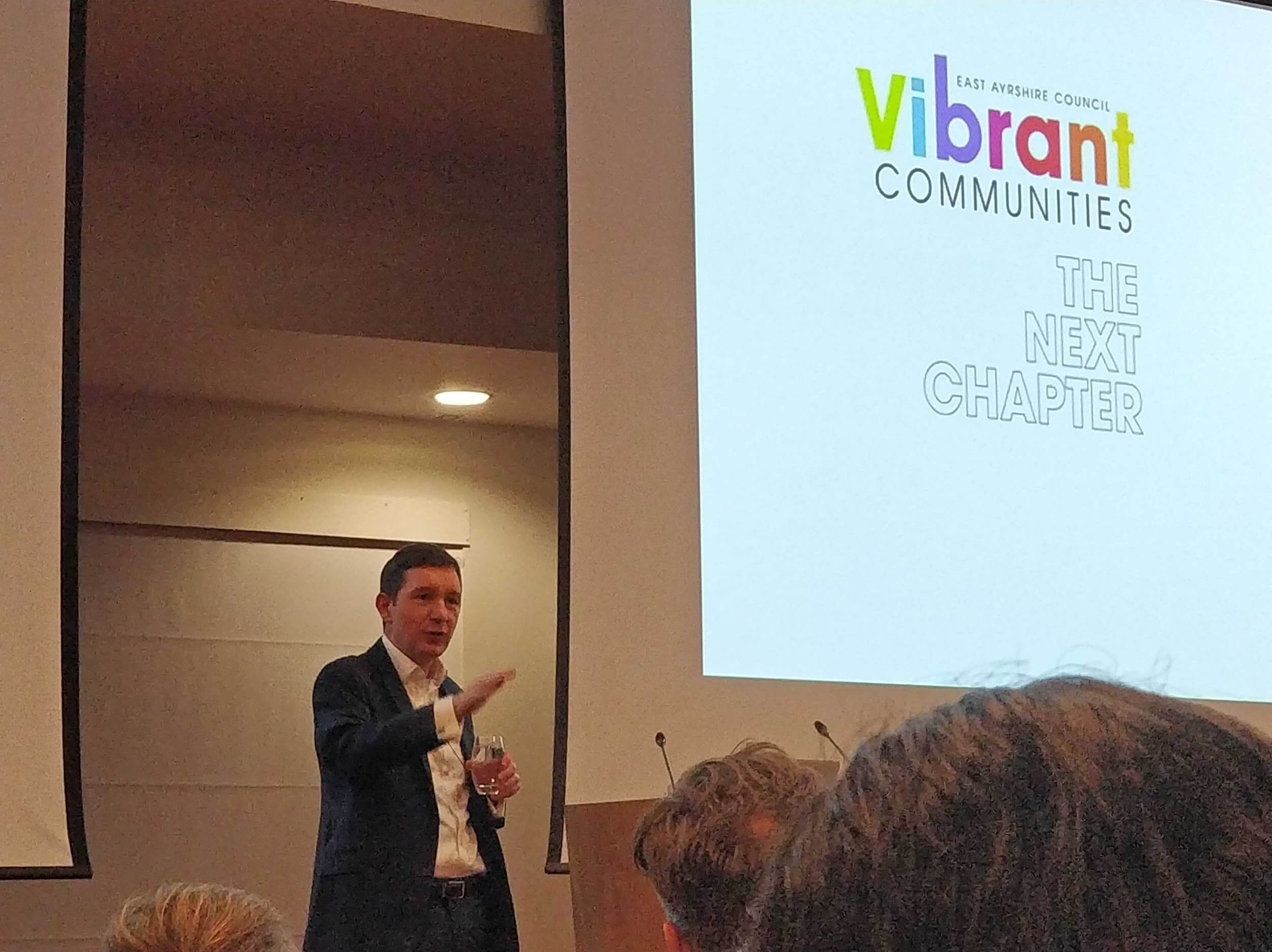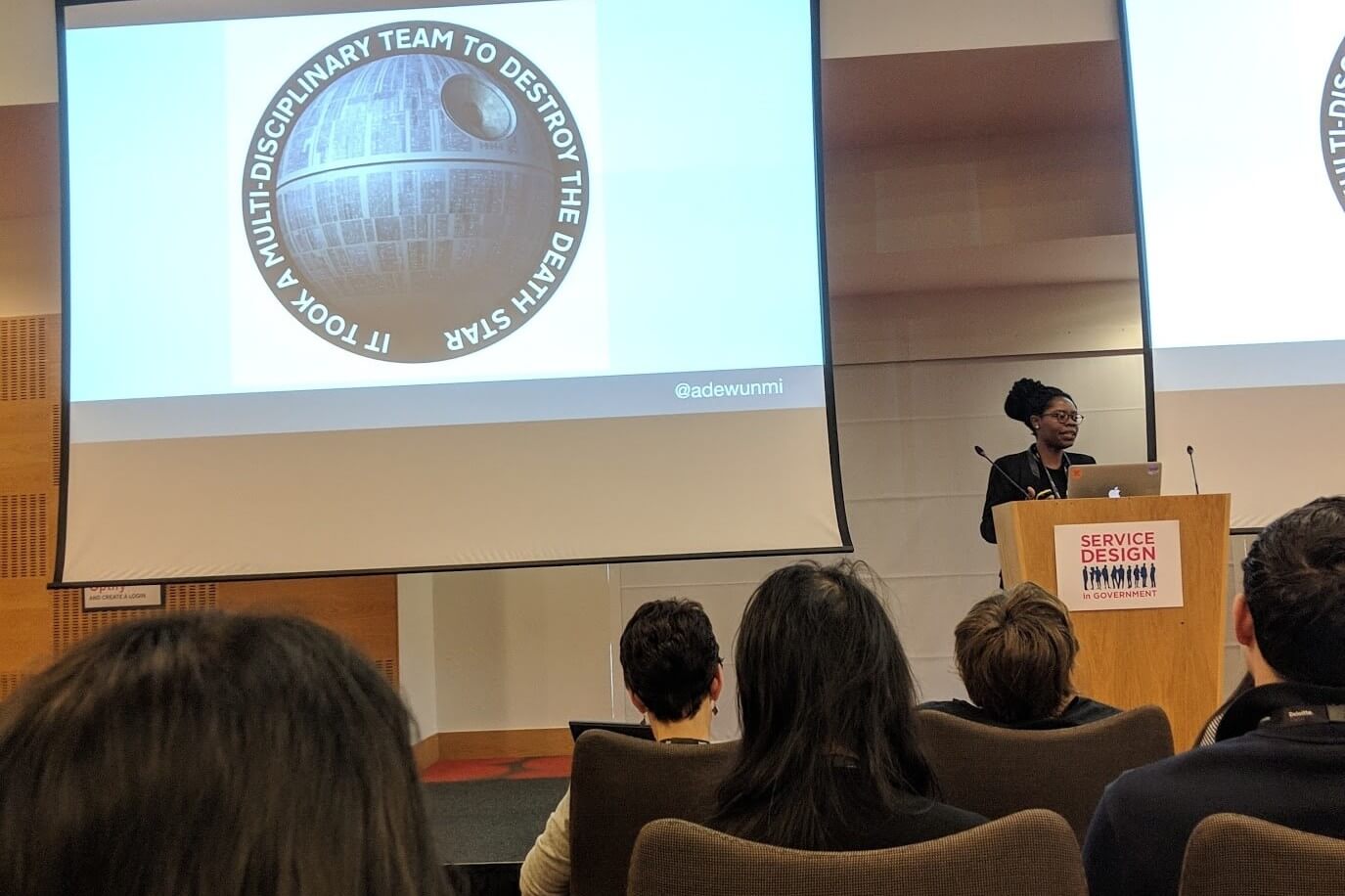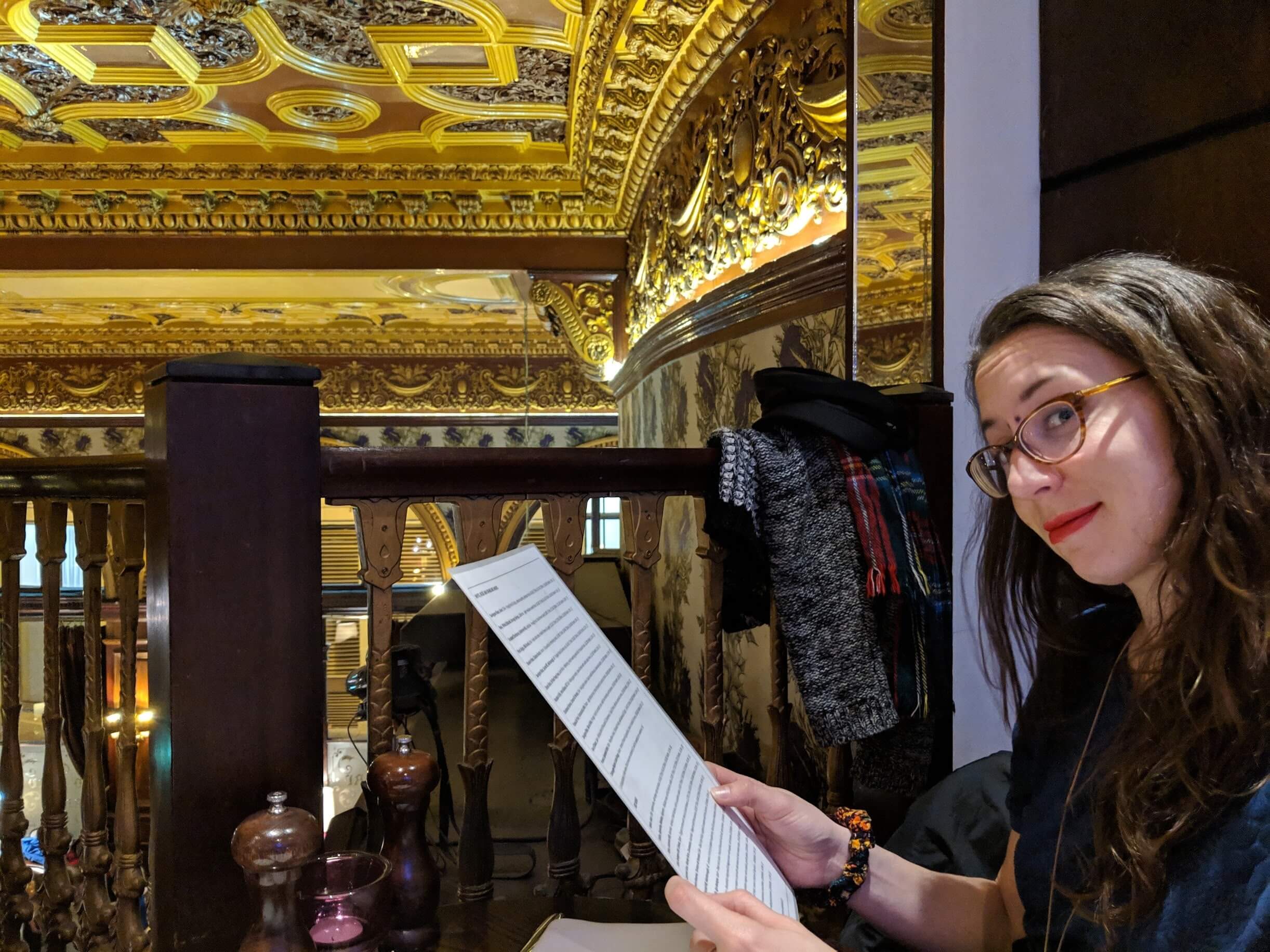Ruminations and takeaways
This year we had the pleasure to attend the Service Design in Government conference in Edinburgh. It was three full-on days of talks, debates, workshops, haggis, neeps, and tatties. There was a lot to take in, and we’ve whittled down our key takeaways to 8.
Diversity is the overarching theme
We were both very impressed about the mix of representation from across government this year — both attendees and speakers. This made for a varied line up and excellent networking over a coffee or glass of wine later on in the evening. Hearing about the challenges that the likes of Houses of Parliament, MOJ, BEIS, and the NHS are facing and how they are using service design to solve problems was heartening. Especially for two service designers with front-line experience of how difficult it often is to get buy-in for what we do within a department. But the more people practising service design (and sharing their experiences) the more chance we have of transforming public services for the better.
More and more organisations are embracing service design, and with a conference as well run and well attended as this — it is refreshing to see that there is a real interest to make things happen that puts the citizen at the heart of the service.
Great keynotes
The headliners delivered.
Every day started with a keynote that shaped the topic of the different sessions of the day. They got the conversation started, and what a great job they did.
Keynote 1:
On the first day Matt Edgar, Head of Design at NHS Digital, opened the conference talking about the importance of creating a space for Service Design to happen and transform organisations from inside out — something that brings many challenges with it, particularly within healthcare.

Matt Edgar, Head of Design at NHS Digital
Key takeaways:
- Always make sure that the person who is going to say “no” is in the room
- A mission & a mindset is not enough, you need the environment to be set up for success
- Address the bottleneck before you think about putting time into improving the button
- User needs within healthcare are at the apex of 3 elements: the clinical, the practical, & the emotional
- ‘Most of government is mostly service design most of the time’
- ‘More of healthcare needs more service design more of the time’
Keynote 2:
We witnessed, Cormac Russell, MD of Nurture Development and faculty member of the ABCD Institute at DePaul University, speak about how to design services to hatch the power of community and the importance of building networks. The fall of Humpty Dumpty from the wall and his subsequent repair failure at the hands of the state (and the coded message therein that we receive as children) was an inspirational thread throughout the talk. His closure was an inspired retelling of the famous nursery rhyme that eloquently brought a fantastic keynote to an end. “But all the king’s horses and all the king’s men couldn’t put Humpty together again” became “But all his neighbours were ready to catch…they built him a nest where was ready to hatch.”

Cormac Russell, MD of Nurture Development
Key takeaways:
- People want a life, not just a service
- The institutional world has limits
- People are more likely to watch Friends than actually be friends with their neighbours
- You can’t work out what people need without knowing what they have
- Silos are where smart people go to do dumb things
- It takes a village to raise a child. But when the village doesn’t do a good job, the child will burn the village down to feel its warmth
Keynote 3:
The last Keynote speaker was Ade Adewunmi, data transformation consultant and all-round smart lady on the junction of digital transformation, data, and delivery. She spoke about looking at data as the new force of disruption and the implications of its second-hand use. It was a fine end to the final day with some thought-provoking ideas about a much misunderstood and much-feared topic to round up the festival.

Ade Adewunmi, Data Transformation Consultant
Key takeaways:
- Service design is the continual process of re-orientating an organisation to focus on user needs
- It took a multidisciplinary team to destroy the death star
- A disadvantage of Agile in government is that you don’t have the time to consider wider implications
- We don’t need any more heroes, we need systems and networks
Great organisation (structure, quality, being looked after)
The conference was very well organised, which was quite challenging due to the number of participants and the full schedule. A keynote address kickstarted the day, before the split into the multiple activities such as workshops, case studies, experience reports, hands-on sessions, workshops, and lightning talks. The structure, timings, and space were organised in a way that it was easy to attend up to 6 activities a day without having to leave mid-session or feeling overwhelmed. There were also some breakout and stress-free areas, such as a yoga room or a massage space, to practice some mindfulness and find peace in the middle of the knowledge wave. We both felt well looked after, and Ben (as a Devonshire boy) appreciated the scones with jam and clotted cream on the final afternoon before the closing note.
Dealing with overlaps and clashes
Having such a full and varied lineup, and only 6-8 hours a day to play with, did however bring its disadvantages. There were more than 60 speakers, therefore, it was impossible to attend everything — and often there were some real hard decisions to be made about which session to attend. Personally, I (Alicia) confess that I had a little bit of fomo (fear of missing out), but between the two of us we were able to organise and plan the day to get good coverage. The organisers have encouraged the speakers to share slides on the Slack channel, and Twitter was a hive of #sdingov2019 activity, so there has been an opportunity to negate the fomo and catch up on some of the missed talks.
A great city setting
“The Scots think of it as their capital; they’re too possessive, Edinburgh belongs to the world.”
Richard Demarco
There’s something refreshing about not being in London for a conference. While it is true that it’s handy to just get back home after each day, staying in a different setting forces you to switch into a more immersive experience and switch off from work so you can participate fully. Edinburgh is a great city break for promoting exploration, discovery, networking, and thinking outside the box for 3 days. Let’s hope that the organisers are able to find a venue in such a fantastic city for next year.

A community committed to sharing best practice
There was a great sense of community in all aspects of the conference. The voices amongst both the speakers and the audience were not trying to sell sell sell: pitching projects or trying to promote themselves, but rather sharing the experiences, and sometimes the struggles, of transforming public institutions using a human-centric design approach. It was a great environment to cultivate connections with both industry colleagues and clients in a constructive and positive way. We both left Edinburgh feeling part of a wider community that will last long after the curtain closed on SD in GOV 2019.
Alicia’s top talks
The three activities that I would like to highlight were:
- A hands-on session on designing for impact by Sarah Josefsberg and Boris Divjak: It was about the theory of change, and how to start planning with a long-term outcome and work out the path to get there. They presented a set of tools based on cards and templates that were just ideal to visualise and spark conversation about new service concepts, intermediate outcomes, and long term goals.
- Cormac Russell’s keynote: on designing for the quality of life, and the personal implications that services create beyond themselves. It was a very inspiring talk about empowering communities and the shift from the individual to the collective.
- A case study on transforming complex spaceflight licensing into a simple digital service by Aimee Smith and Alex Wotton: How service design takes the role of making complicated issues easy and empowering citizens by understanding an otherwise very niche topic.
BLG’s top talks
My highlights involved the London sewage system, GDS assessments, and how our services are failing victims of domestic violence.
- ‘A talk about poo — systems thinking and cholera’: Sarah Drummond from Snook used the story of John Snow and his plight to prove to the Victorian government that cholera was water-borne, to frame how ‘systems thinking’ could be the way to go about changing the system. It was an innovative way to come at a problem using a fascinating historical story, and the takeaways were rife. “You might not be the change, but you could be part of the ripple that eventually causes change.”
- A talk about GDS assessments and what makes a good one: Steve McCready, Sam Villis, and Clara Songaila delivered an illuminating session on ‘Creating safe spaces for challenge — being a lead assessor for Government Service Standard assessments’. As someone who has been through many assessments, with contrasting experiences, I found it very useful to hear about what GDS is aiming for in terms of how they assess public services at Alpha and Beta. The message was it should be about: collaboration, community, and honesty vs ‘job interviews’, scaremongering, and fear. They fielded some tough questions about how they ‘assess the assessors’ and what GDS is doing to improve upon the current process to ensure consistency and quality.
- A talk about domestic violence: I’ve never cried at a conference before but the hard-hitting hour with Janice Hannaway had me in pieces as we were taken on the journey that domestic abuse sufferers must navigate across public services. ‘Why doesn’t she leave’ brought home why it is so important to do what we do and do it well. For the sake of victims like ‘Ellie’ who must relive her story again and again and again and again with each public sector organisation responsible for delivering just a tiny part of the single service she should have to get her life back.